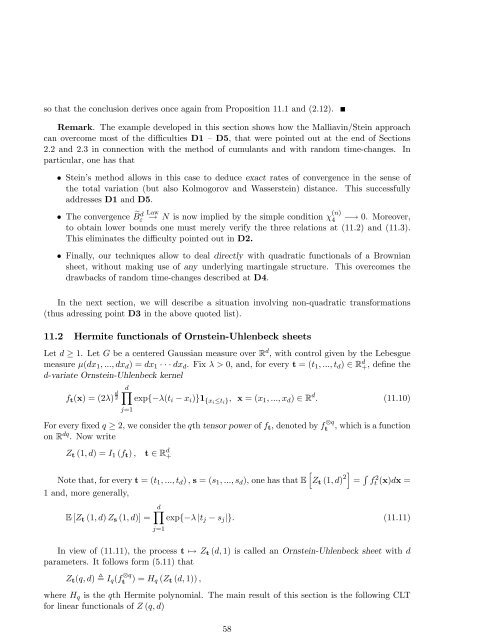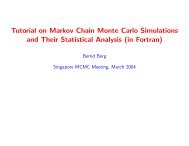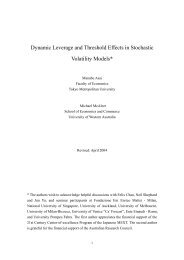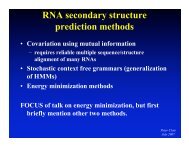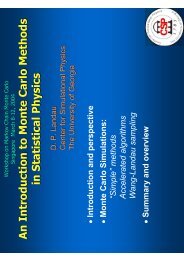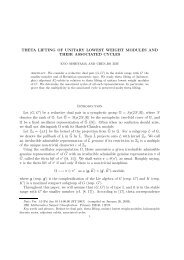Stein's method, Malliavin calculus and infinite-dimensional Gaussian
Stein's method, Malliavin calculus and infinite-dimensional Gaussian
Stein's method, Malliavin calculus and infinite-dimensional Gaussian
Create successful ePaper yourself
Turn your PDF publications into a flip-book with our unique Google optimized e-Paper software.
so that the conclusion derives once again from Proposition 11.1 <strong>and</strong> (2.12).<br />
Remark. The example developed in this section shows how the <strong>Malliavin</strong>/Stein approach<br />
can overcome most of the di¢ culties D1 – D5, that were pointed out at the end of Sections<br />
2.2 <strong>and</strong> 2.3 in connection with the <strong>method</strong> of cumulants <strong>and</strong> with r<strong>and</strong>om time-changes. In<br />
particular, one has that<br />
Stein’s <strong>method</strong> allows in this case to deduce exact rates of convergence in the sense of<br />
the total variation (but also Kolmogorov <strong>and</strong> Wasserstein) distance. This successfully<br />
addresses D1 <strong>and</strong> D5.<br />
Law<br />
The convergence B e "<br />
d ! N is now implied by the simple condition (n)<br />
4 ! 0. Moreover,<br />
to obtain lower bounds one must merely verify the three relations at (11.2) <strong>and</strong> (11.3).<br />
This eliminates the di¢ culty pointed out in D2.<br />
Finally, our techniques allow to deal directly with quadratic functionals of a Brownian<br />
sheet, without making use of any underlying martingale structure. This overcomes the<br />
drawbacks of r<strong>and</strong>om time-changes described at D4:<br />
In the next section, we will describe a situation involving non-quadratic transformations<br />
(thus adressing point D3 in the above quoted list).<br />
11.2 Hermite functionals of Ornstein-Uhlenbeck sheets<br />
Let d 1. Let G be a centered <strong>Gaussian</strong> measure over R d , with control given by the Lebesgue<br />
measure (dx 1 ; :::; dx d ) = dx 1 dx d . Fix > 0, <strong>and</strong>, for every t = (t 1 ; :::; t d ) 2 R d +, de…ne the<br />
d-variate Ornstein-Uhlenbeck kernel<br />
dY<br />
f t (x) = (2) d 2 expf (t i x i )g1 fxi t i g; x = (x 1 ; :::; x d ) 2 R d : (11.10)<br />
j=1<br />
For every …xed q 2, we consider the qth tensor power of f t , denoted by f q<br />
t , which is a function<br />
on R dq . Now write<br />
Z t (1; d) = I 1 (f t ) , t 2 R d +<br />
h<br />
Note that, for every t = (t 1 ; :::; t d ) ; s = (s 1 ; :::; s d ), one has that E Z t (1; d) 2i = R ft 2 (x)dx =<br />
1 <strong>and</strong>, more generally,<br />
E [Z t (1; d) Z s (1; d)] =<br />
dY<br />
expf jt j s j jg: (11.11)<br />
j=1<br />
In view of (11.11), the process t 7! Z t (d; 1) is called an Ornstein-Uhlenbeck sheet with d<br />
parameters. It follows form (5.11) that<br />
Z t (q; d) , I q (f q<br />
t ) = H q (Z t (d; 1)) ;<br />
where H q is the qth Hermite polynomial. The main result of this section is the following CLT<br />
for linear functionals of Z (q; d)<br />
58


